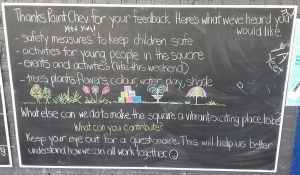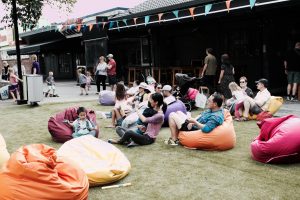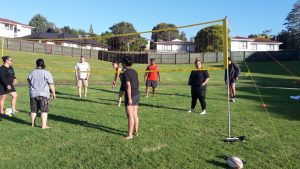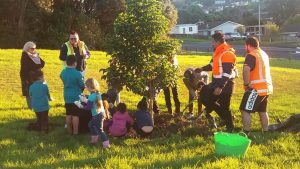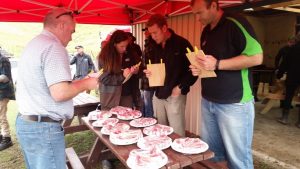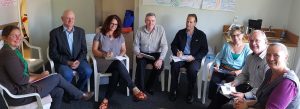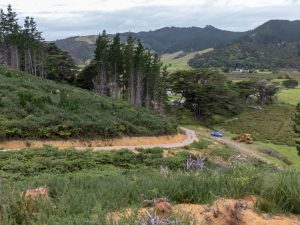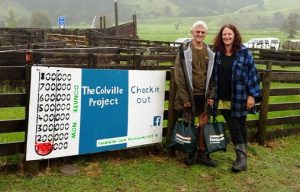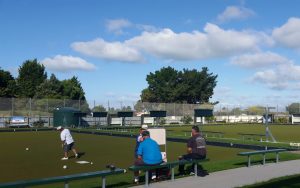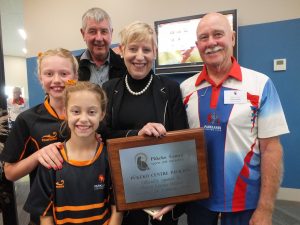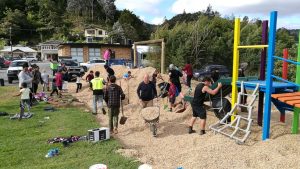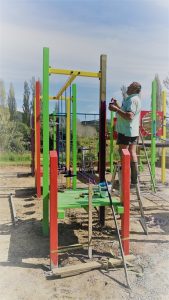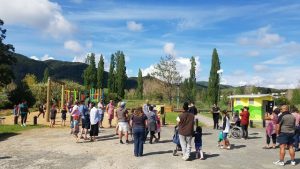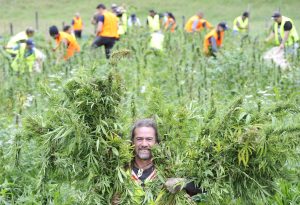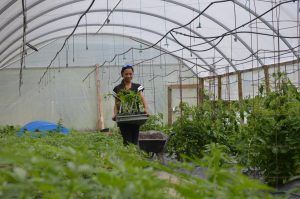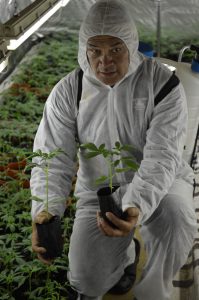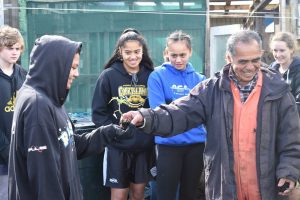Community at the heart for Point Chevalier
Project Background
In 2017 the Albert Eden Local Board allocated funding for “the coordination and activation of a placemaking initiative in Pt. Chevalier focused on the town centre”. The aim was to revitalise the Point Chevalier town centre into a vibrant and inclusive space.
Some challenges like poor town planning, local building expansion and development and reduced community policing were historic. Others, like poor media portrayal of the town centre and issues with social behaviour and rough sleeping, were just emerging.
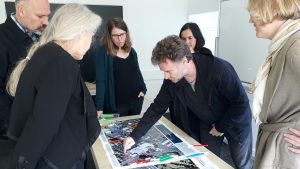 Finn Mackesy is no stranger to the Point Chevalier community, having co-founded Transition Point Chevalier and co-coordinated the Point Chevalier Treasure Hunt a decade ago. He also works at Resilio Studio. As well as landscape, urbanism and architectural design, Resilio’s focus is on social innovation, education and facilitation. They support a range of projects in Tāmaki Makaurau, from public open space development to curriculum development, placemaking, social labs and community empowerment. Finn and his team are driven by the desire to support Auckland communities and focused on solutions that encompass positive and transformative change. They wanted to be part of this project so they took on the role of coordinating and facilitating a co-design process with other stakeholders in the community.
Finn Mackesy is no stranger to the Point Chevalier community, having co-founded Transition Point Chevalier and co-coordinated the Point Chevalier Treasure Hunt a decade ago. He also works at Resilio Studio. As well as landscape, urbanism and architectural design, Resilio’s focus is on social innovation, education and facilitation. They support a range of projects in Tāmaki Makaurau, from public open space development to curriculum development, placemaking, social labs and community empowerment. Finn and his team are driven by the desire to support Auckland communities and focused on solutions that encompass positive and transformative change. They wanted to be part of this project so they took on the role of coordinating and facilitating a co-design process with other stakeholders in the community.
Work with diverse people and sectors
A key characteristic of CLD is working with a diverse range of community stakeholders, so the project team intentionally included local council staff along with local organisations, businesses and residents in their core group.
“The ideal situation is to collectively define what the problem is and the challenges you are taking on. Then you are sharing the work in terms of trying to understand and analyse those problems and collectively generate solutions” explains Finn.
In total there were more than 10 project partners and 15 additional groups engaged in the process, including Auckland Council, Pt. Chevalier Social Enterprise Trust, Transition Pt. Chevalier, Pt. Chevalier RSA, Nomad, Learning at the Point Community Kindergarten, Auckland Transport and local residents.
Resilio Studio and its Placemaking Project partners spent several months researching, networking, observing and mapping the area. They started by “focusing on the known issues, impacts and concerns” and went from there. Their purpose was to “work together to improve the experience of living, working and playing in and around the town centre”. The second stage of the project is to focus on the activation of the local square and working to improve connectivity and safety in the town centre.
Building diverse and collaborative local leadership
Throughout the process there were ongoing opportunities for the project group to meet with influencers and decision makers whose work impacted on and continues to influence Point Chevalier.
Finn says a significant highlight was witnessing “the placemaking group becoming the local experts on local matters and having influencers and decision makers coming to them for information, insights and perspective”.
Community-led development has informed Resilio Studio’s business practice since they began three years ago. Inspiring Communities has provided a source of inspiration and models of good CLD practice which continue to shape the way it works and the way the Point Chevalier Placemaking Project operates.
Learn by doing
It can be difficult in this type of project to translate outcomes into numbers. Many changes will be gradual, rolling out over a 10 year period, but will be influenced by decisions made in the immediate and short term.
At the beginning of the project, few people seemed to “appreciate the scale of change happening in and around the town centre”, according to Finn. However, as community engagement progressed, a shift in focus occurred from “trying to improve existing public spaces to influencing and helping the community to shape coming changes to best serve the community”.
You can find more about this awesome project here.
Sustainable change through leadership
Sport Waitakere’s purpose is simple – to make a positive impact on West Auckland residents and their lives through sport and recreation. Since 1991, Sport Waitakere has been working within the boundaries of Auckland Council’s three local boards: Whau, Waitakere Ranges and Henderson/Massey. It’s a diverse and complex environment to manage, especially given that at any one time they can have more than 60 projects on the go.
Sport Waitakere has recently learned and implemented some valuable lessons that have helped them to be more sustainable.
Grow from shared local visions
When Sport Waitakere community broker Antonia Vai took it upon herself to do things a little differently in the Waitakere Ranges Local Board area, things quickly started to change.
Jasmine Graham, from Sport Waitakere, explains: “Antonia was quick to understand the importance of bringing local organisations together to support the opportunities within that community, allowing the people of that community to be the experts and providing a platform for local champions to thrive”.
As an example, Sunvue Park in Glen Eden was equipped with a basketball hoop and playground equipment. However, not many people were using the park, so Antonia decided to find out why. By mapping what was already happening in the area and engaging locals, it was quickly established that a volleyball net would have been a better investment. Through her ongoing networking with other agencies in the area, Antonia found out that a local community hub was getting rid of a volleyball net. It was an easy fix.
Lack of shade also impacted on use of the space during the warmer months. After a few meetings with Auckland Council and Waitakere Ranges Local Board and with the support of Healthy Families Waitakere, more trees were soon planted.
A relationship with Inspiring Communities was already underway which helped Sport Waitakere to understand a community-led development approach. Furthermore, once an understanding of this level of community engagement was put into action, Sport Waitakere started to evolve all its operations to a more community friendly approach.
“What Antonia did was pretty special,” Jasmine says. “By getting back to the basics and simply asking the community what they wanted in their park we realised the assumptions on the way spaces were being used were not entirely true”.
Learn by doing
Jasmine says the very first value of Sport Waitakere was “lead from the front” which resulted in engagement with and providing solutions for the community. She says “we’d offer advice, expertise and leadership to our community” which was well intentioned, but didn’t work so well in terms of having a “sustainable impact within our community”.
Better-used park spaces and greater care of the environment were some of the results from this new way of working. This quickly attracted attention from local board funders and changes were made to the Community Broker contracts to reflect this way of working.
“As community brokers, we are now given freedom to work in a community development framework,” Jasmine explains. “We can have open dialogue with local communities, groups and residents on how they use spaces for activities and how we can better support that. It opens up more opportunities to collaborate with existing groups on what is already happening and what’s working”.
Grow collaborative local leadership
This has also resulted in changes to Sport Waitakere’s value statements. “We lead from the front” has been amended to “We build leaders”. Leadership needed to happen from within the community by Sport Waitakere working with the community instead of for them.
Jasmine says the changes from inside and outside the organisation are a lot more sustainable compared to how things have been in the past and that changing from “an asset-based perspective” to one of “championing local leaders” drives a greater change within the community.
Work with diverse people and sectors
Support for implementing these changes has come from many groups, including Inspiring Communities. Jasmine says the organisation still has “much to learn and improve on” and is looking forward to ongoing support as the journey continues.
Colville building a healthier rural community
Picturesque Colville sits near the top of the Coromandel Peninsula. Located 26km north of Coromandel town, it’s located within the Northern Coromandel: a rural, remote region with a small community of around 700 residents, except in the peak of the tourist season, when the population swells to over 10,000 people. The emergent issue facing the town and the wider area is a lack of infrastructure to support not only the seasonal tourist population, but also the community in general, which has to travel out of Colville for many essential services. The Colville Project is an attempt to address these issues with the provision of an all-in-one community and health centre that would deliver much needed services from one central location. The vision is that this project and the centre will regenerate the community, making it a much better place to live and encouraging people to stay in the area.
The Challenges and the Response
Bronwyn Blair, the project spokesperson, has lived in the area for over 20 years. She explains the challenges the area faces.
- Healthcare: The current health clinic has no running water in its consultation rooms and limited space. Minor surgeries and other procedures are done in a portable sterile room outside the clinic so that people don’t have to travel up to four hours’ return to Thames Hospital.
- Employment: Many people have to move away to start a career or find full-time work.
- Education: Anyone needing ongoing education and training needs to look elsewhere. The primary school population isn’t stable which impacts on both current and future student populations and the community as a whole.
- An aging population: There are very few rental properties for people moving into the area. It’s a popular place for retirement but doesn’t have the infrastructure to support more retirees.
The Colville Project (TCP), which is run as a community partnership between the Colville Community Health Trust (CCHT) and Colville Social Service Collective (CSSC), is ambitious; it’s all about the regeneration and sustainability of the community.
Bronwyn summarises: “We want to create an opportunity for a health and well-being based industry that will contribute to the sustainability of rural practices across the country, and support holistic well-being, including training, in integrated practice. This will contribute nationally and regionally, and bring employment locally”. For that to happen, there have to be facilities that deliver the services needed by the community. This is what the new health and community centre would provide.
There are four parts to the project. Stage One is the well-being and education centre; Stage Two is Staff and Student Accommodation; Stage Three is to build affordable housing and support for families and older people; and Stage Four is to create youth recreation and training opportunities.
Shared local visions drive action and change
Bronwyn, who is also the Chair of the CSSC, says both organisations wanted a healthy and thriving rural community. “But we wanted to think more broadly than health”. They wanted to reach as many people in the wider community as possible. They came up with a shared vision, then a proposal that they took to the community in the form of consultation workshops. They took a slightly different approach with their consultation. Bronwyn explains that “instead of having one central workshop which would mean people having to travel significant distances, we held workshops in four different areas within the Northern Coromandel region”. They gathered feedback, answered questions and examined the communities’ aspirations. They had around 130 people attend across the region. Bronwyn says this was really effective as they found that the demographics were different in different areas and they couldn’t have captured as much information in just one workshop.
“It was very clear that over 90% of the population wanted this project for the community, which was a good driver to go ahead. What was proposed is actually what we want. To see complete alignment in that was really wonderful” says Bronwyn.
As well as community consultation, research was undertaken, including an independent feasibility study which found that the project would be of significant benefit to the community and a great support for it.
Using existing strengths and assets
The first step is to purchase land. A 32 hectare piece of land has been identified as suitable and the project team is now fundraising to buy it. At first, they thought that putting different facilities in different locations would best serve the wider community. However, after consultation, it was found that the community wanted all of the services to be in one, central location. Bronwyn believes strongly that the community needs to have ownership of the land. “Many fundraising opportunities are now being driven by the community, with the Project Team just keeping the ball rolling”.
Many people, groups and sectors working together
However, the 700 permanent residents of the Northern Coromandel cannot do this alone. The plan is to reach out to the wider community who visit, live, work and play in the Coromandel, and individuals and groups across New Zealand who share similar aspirations for the area.
Community Waikato helped them with their strategic plan and they secured some external funding from the Department of Internal Affairs who awarded CSSC a three year Community Development Scheme grant. This allowed them to hire two community development workers to support several community development projects, TCP being one of them.
In addition to this, the Project Team has launched a fundraising drive, which included not only asking for charitable donations through their website, but also running community-led campaigns and events such as the Great Lamb Chop Competition, the Colville Dine and Dance event, Papa Aroha community dinners, fruit sales by community members with surplus produce, the 100 Hippies Campaign and The Colville Family Reunion – an evening of Colville-connected bands playing at The Thirsty Dog in Auckland.
“Our community has given around $170,000 towards Stage One, the Wellbeing and Education Centre” says Bronwyn. “The local community is totally behind the project”.
The project has raised around 28% of the funds needed for the purchase of the land.
Working adaptively, learning informs planning and action
The team is now setting up a third trust: the Colville Project Trust. Bronwyn says it’s really important to take time to get the right trustees and to set the trust up for success. She adds that “it has always been part of our vision. It has been a massive undertaking, a massive learning curve”. She stresses the importance of keeping careful records of your processes and also recording positive experiences and learnings as you go. Bronwyn says they want to “become a beacon for other small communities around the country if not the world. If this learning can go out further, that’s a real outcome.”
“We have to pull together to determine and make a positive future for ourselves, our kids and for all the people who live, work, play and visit so that we have the services and amenities we need for daily life – and to provide and generate opportunities to continue to live here, socialise, train and upskill and find employment so we have a productive, sustainable community, built on the principles of care for people, for the environment, for a better, kinder future”.
But they have a long way to go yet. “It’s a big vision and one we can achieve together, as a united community” says Bronwyn.
To learn more about this fantastic initiative and how you can support it, check out the TCP website and their awesome video below.
The Pūkeko Centre: A shared vision in East Christchurch
The Parklands community in East Christchurch was badly affected by the 2011 earthquakes. This is a story of how two unlikely collaborators came together to create something new for the whole community, using a community-led approach.
After the February 2011 earthquakes, both Parklands Bowling Club and Parklands Rugby Roosters club found themselves without a home. The bowling club’s greens had been ripped apart by the quakes and badly damaged by liquefaction and their pavilion was in a state beyond repair. At the same time, Parklands Roosters Rugby club changed overnight from a sports club to a “welfare club” according to the former Chair, Maurice Lawlor. The club sprang into action to support its members, who were devastated by the quakes. The earthquakes had also caused damage to the Roosters’ base and so, they were looking for a new home as well. Together, the two organisations came up with the idea of creating a new centre that both clubs could use, which could also be opened up to the wider community. This marked the start of a wonderful collaboration by the two clubs to build not only a new clubroom, but a new community centre.
Many people, groups and sectors working together
The process started with a lot of community consultation and some support from other organisations. Lawlor, now the Chair of the Pūkeko Centre Committee, says that Christchurch City Council and the local residents’ association helped the newly formed committee to identify community groups in the area who might be interested in using a new community facility and from this, networking groups were formed, made up of interested individuals, organisations and local businesses. The committee also engaged with the Burwood-Pegasus Community Board on a regular basis and have had a lot of support from Sport Canterbury. Lawlor added that they also had a trade show to which they invited all the community groups. This was an opportunity to “talk about what their needs were and to share our vision”, he says. Lawlor explains that the committee ran an independent capability study which included consulting a wide range of groups. They also engaged an external consultant, who came in to facilitate community discussions around what was needed. The community had input into the name of the centre as well. It was chosen due to the fact that female pūkeko all lay their eggs in the same nest and the eggs and chicks are then nurtured by the whole community.
Using existing strengths and assets
Building a new clubroom was going to be too expensive, so they needed to think outside the square. This resulted in two buildings at the local, closed Freeville School being identified as suitable for the project. They had previously been destined for demolition, but were then gifted to the committee by the Ministry of Education. The buildings were relocated onto the bowling club site, a new foundation was added and a compete refit carried out to turn the building into a modern multi-purpose pavilion. These are now being redeveloped into a multi-sports, recreation and community centre.
Shared local visions drive action and change
The vision was always that the centre would be more than a sports club. Lawlor says that “other groups needed a space. People needed connectivity”. He explains that the idea is that the Pūkeko centre will give community groups a home, allow them to connect, leverage off each other, reduce duplication and grow their own projects. There are a number of groups who are already using the centre and many more that want to set themselves up as regular users, such as Girl Guides, Brownies and health and fitness and senior card groups, plus a number of support networks. Parkview Primary School is located right next door and its Principal, Simon Thomas, says that the clubrooms are currently being used for socialising by the teachers and, in the not-too-distant future, school assemblies will be held at the centre once the hall is built. Parkview doesn’t currently have a big enough space for whole school assemblies, community presentations or other large school gatherings. It may be 5 – 10 years before they can afford to build their own hall so, in the meantime, they are happy to have this arrangement with the Pūkeko Centre. In addition to this, there is an agreement with Sports Canterbury which will allow the school children to start learning to bowl at the club in future. Thomas values the Pūkeko centre as it’s “community driven, has the same vision as the school and there is a great relationship and great community desire” for such a space.
After a lot of hard work, fund raising and help from sponsors, philanthropists, funding bodies and private donors, Stage 1 was completed and was opened by the Mayor of Christchurch, Lianne Dalziel, on 24th February 2018. The clubroom building features a bar, a kitchen, meeting spaces and a free community library corner with comfy couches. The space has lots of natural light and a welcoming feel. Funds still need to be raised for Stage Two, which will result in the opening of the hall (hopefully at the end of this year); Stage Three, which will see a breezeway built and the car parking area finished; and Stage Four, which completes the project with the final landscaping and outdoor court construction.
What will success look like?
The Pūkeko Centre has already achieved a lot, but they have still have so much they want to accomplish for their community. Wayne Eden, a committee member, says that “success will show when we see a vibrant and well-used complex with a reputation for its supportive and welcoming environment. Our very generous sponsors and funders will be able to take pride in the fact that they have contributed to a very valuable community asset.”
Eden concludes by saying “having met and worked with such a large number of community-minded people who have been so generous with their time, support and encouragement along our journey has been totally rewarding and makes it all worthwhile.”
If you’d like to learn more about the Pūkeko Centre, check our their awesome video!
The Pukeko Centre – Our story from Belmont on Vimeo.
Whangaroa Community Playground
The residents of Kaeo – a town of 450 in the Far North – have come together to bring colour and play into their community. When Eljon Fitzgerald took his two year old granddaughter to the town’s playground only to find nothing that she could play on, he decided to take action into his own hands. The local community came together in force to back the project.
Building on their existing strengths and assets, the project team tapped into many different opportunities to bring the dream of the playground to life. Using the Whangaroa Community Trust to secure funding, they received support from the Far North District Council (FNDC) and a local fundraising group called Kaeoannes to purchase a secondhand playground with the help of the Kerikeri Lions Club.
To locate the shortfall, residents and local businesses pooled their resources to create a raffle that raised the final $5000 towards the installation of the playground. The rest came down to the hard work of community members, like Bruce Mills, his daughter Georgia, and Eljon who spent hours painting and sprucing up the old playground. In a fantastic show of community spirit over 100 people answered the call to help lay and spread the bark FNDC had supplied.
What was once just a climbing frame and two swings is now a multi-activity playground for kids of all ages. Putting local initiative at the heart of this project has resulted in the playground becoming a central hub that has brought the whole community together.
“Kaeo has been buzzing with activity and not a day goes by without the playground area being full of kids and parents.” – Eljon Fitzgerald
Shared local visions driving action and change
Thanks to the vision of community members, the support of local businesses and community, and the guidance of the FNDC recreational services division, the collective desire to change a rarely-used area into a vibrant community playground and recreational area for families has been realised.
Building diverse and collaborative local leadership
The project was led by motivated community members and the Coordinator at the Whangaroa Community Trust. This mixed leadership allowed the voice of the community to remain strong in decisions while creating an official pipeline to essential resources and permissions necessary to be able to build the playground.
Using existing strengths and assets
Other than the installation of the playground, which required professional services, the entire project was facilitated through the work, support and donations of community members.
Kaeo may be a small town but we have all the skills of larger towns and cities within our community. A strong volunteer workforce including young and old, tradespeople, parents and retired folk who have given freely of time to achieve this result. – Angela Norman, Community Coordinator.
The installation of the Whangaroa Community Playground is just the beginning for this small community who have been inspired by the changes they have been able to make for themselves. The initial leadership group plans to form a ‘Friends of the Playground’ group in which the goal would be to continue to build a welcoming hub for all visitors.
With the aim of becoming the coolest town playground in the far North, they are setting their sights high. They hope to develop a family area that offers picnic tables, BBQs and shade and have future dreams of a skate path and a flying fox.
The determination of the residents of Kaeo to build a place of fun and exploration for their youngest members has illuminated the necessary steps for change, allowing their vision to grow and flourish and creating lasting impact within their community.
Hemp venture places community at the heart of business
Hikurangi Enterprises, a charitable company based in Ruatoria, is placing local employment and environmental sustainability at the centre of a hemp growing venture that aims to build economic development in the Tairāwhiti region.
As a business enterprise, they offer a strong example of how local businesses can incorporate community-led development principles to enhance well-being, engagement and ownership within their communities.
Hemp is the same plant as marijuana but with low-THC (tetrahydrocannabinol) so it doesn’t carry the psychotropic effect. It is increasingly sought after for its medicinal properties, the market this venture is capitalising on. With the perfect climate and a wealth of existing local knowledge and expertise, hemp offers a high value alternative to marijuana for the region.
Using existing strengths and assets
There are 15 local growers already involved in the venture with 300 years growing experience between them. They are the experts in the field and have provided the tools and resources to trial varieties and develop a premium quality crop.
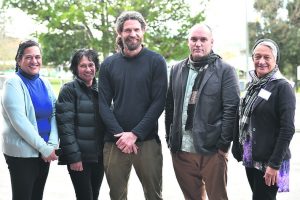
Viewed positively by the local community, many landowners have offered blocks of land for growing hemp when the venture is ready to scale up.
“People are willing to give anything a go that has some real potential and that is aligned with community values. This is seen as consistent with the values of whānau and landowners in a way that other opportunities [such as oil and gas exploration] aren’t.” – Manu Caddie of Hikurangi Enterprises
Working adaptively, learning informs planning and action
Flexibility is essential to this venture as the social, political and legal landscapes around growing and selling hemp are constantly shifting. It is a brand new industry in Aotearoa that is highly regulated. These factors make investors cautious.
After a successful crop trial in 2016, Hikurangi Enterprises is in the process of strengthening local and international business relationships, working through complex regulation laws and market testing their products.
There are many hurdles yet to be faced but the community remains confident in the venture. They are developing a business model that encourages local community investment and protects growers so that they can collectivise and have ownership over the production space.
“We’re trying to be community-led and owned in real ways. That includes making sure the community has tangible ownership not just philosophical.” – Manu Caddie
Even at these early stages, the positive community impacts are visible. Hemp growers can work with the plant they know and love without risking arrest and time away from their families. They are seen as making positive contributions to whānau well-being and the development of the region. Alongside the obvious economic benefits for the area, these shifts in perception allow the flourishing of a strengthened and empowered community.
“Locals who had been seen as dope growers are being seen as productive contributors to local economic development and hard working horticulturalists. They are sensing that change already.” – Manu Caddie
To find out more about the work of Hikurangi Enterprises visit https://hikurangi.enterprises/.
Ōpōtiki on TV
Ōpōtiki is sure doing things the community-led way. The long journey continues. It’s great to watch them acknowledge and celebrate their amazing achievements to date. It’s been a privilege for Inspiring Communities to walk alongside and support Ōpōtiki’s kaupapa and mahi for many years.
Watch Seven Sharp’s story about their Mussel Farm
Network Survey 2017 Results
CLD Trends and Next Steps for IC – What you’ve told us!
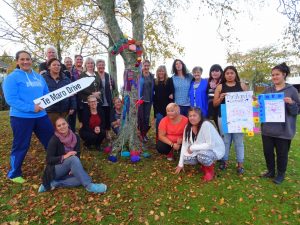
“Inspiring Communities is a unique organisation in NZ and offers considerable expertise and practical help in community-led development policy and actions.”
IC Network Survey Respondent, November 2017
Thanks to everyone who took part in our biannual IC Network Survey. Around 200 people from diverse places, sectors and CLD perspectives shared their views on both community-led development trends and future directions for Inspiring Communities.
In terms of the big picture, 67% of survey respondents agreed that the profile and awareness of CLD has increased in the last few years – up from 60% in 2015. Belief in the importance of CLD to New Zealand’s future also strengthened this year to 92%, up from 85% in 2015. The need to do more to strengthen community leadership in Aotearoa was also recognised – up 8% to 92%.
Interestingly, perceptions of local and central government understanding about CLD both dropped in the latest survey results, as did business-community understandings of their mutually supportive roles:
- There is a good understanding of CLD within local government (18% in 2017, down from 23% in 2015)
- There is a good understanding of CLD within central government (14%, down from 18%)
- Local communities really understand their role in supporting local businesses (22%, down from 29%)
- Local businesses really understand their role in supporting local communities (19% down from 24%)
While reasons for changes in perceptions are not entirely clear, some respondent comments offer clues:
“The understanding of CLD seems varied and uneven across the country.”
“Within central government there is much talk about the complexity of social problem[s], the need for joined up responses and much talk about client and whanau-centred approaches etc, but little understanding/awareness of how you achieve this at a community level or the need to use a community development approach.”
“There is lots of use of CLD concepts and words in local government but little active brokering or resourcing.”
“The new government brings opportunities for expanding CLD in central government.”
Two thirds of respondents agreed that Inspiring Communities has contributed to the growing profile and understanding of CLD in Aotearoa, with 62% noting that CLD learning tools, stories and tips from IC had helped them in their CLD practice during the last year. Again, hosting international speakers and thought leaders topped the most valued part of IC’s work, followed by our email newsletters and website.
In terms of what other things people wanted to see Inspiring Communities do in 2018, there were two clear favourites:
- More regional networking to connect those interested/involved in CLD (82%)
- More skills based CLD workshops, training and events (80%)
Others commented on the need for IC to do more tailored training with specific audiences like local government, business and central government. Those in rural communities also requested more self-directed/online learning support so that distance is not a barrier to CLD learning and training. Another idea was for IC to generate and host a new CLD capability fund that communities could tap into to contract their own mentors, action researchers, facilitators and trainers from other communities.
The need for Inspiring Communities to do some more intentional tracking of trends in relation to both ‘iwi, hapū and mana whenua-led’ development and CLD was noted, with overall tracking of trends in both dimensions of overall CLD seen as important. We agree, and will build this into the work we’ve kicked off to explore what makes CLD in Aotearoa different to that happening elsewhere in the world.
Our team will process all your suggestions and ideas as we prepare our 2018 Annual Plan. We’ll also be in touch in the New Year with those who wanted to chat about opportunities to work more closely with your community or organisation. It’s going to be another exciting year!
Action Builds Westport Community
What started as a dream for a few members of the Buller Cycling Club to make biking more accessible in Westport has, over seven years, morphed into a full-scale community supported initiative. The project includes eight kilometers of cycle and walking tracks, boardwalks and bridges. Powered by over 15,000 volunteer hours, all sectors of the community have united under a shared local vision, driving positive change for their town. And they’re not stopping there.
“What we’ve learned is that the process of doing what we’ve done has given the people of Westport a new perspective on the town. That has become more of a driving force for us” – Glenn Irving, Buller Cycling Club
Relying entirely on the existing strengths and assets within the town, they borrowed the diggers, compactors, chainsaws and tractors necessary to clear the mountains of gorse, plant trees and develop the tracks that now grace the Kawatiri Beach Reserve.
Local businesses have stepped up in support. When the community came together to construct a 200m long boardwalk as part of the Kawatiri River Trail, the local Mitre 10 donated $15,000 worth of materials, engineers donated resources and time, and one of the local cafes delivered lunch for the volunteers every day for two months.
The construction of the boardwalk began just one week after the closure of the Holcim Cement Plant, one of the biggest employers in the town. At a time of hardship for the community, this project proved incredibly unifying and positive, and many of those who lost their jobs were able to volunteer their time.
A key element to long-term success has been keeping it fun and not getting bogged down with meetings and procedure. The organising team have two meetings a year. The rest is worked out while building the tracks or over the phone.
The Buller District Council has been increasingly supportive as it has built a relationship of trust with the Buller Cycling Club that now allows for more flexibility and ease of access to resources. “The Council has realised that making life easy for us is beneficial for everyone,” says Glenn Irving of the Buller Cycling Club. “The first time I applied to get consent to put a sign up on a track I had to pay $600 and do heaps of paperwork. Now when we need building consent, I just send an email, it costs nothing and we can get started in a week.”
The long term goal is to reconnect the town of Westport with the Buller River which is cut off by an underutilised railway line. Glenn is already forging relationships with Kiwirail and the Harbour to make this dream a reality.
“People have seen that we can get things done for ourselves, that we have the expertise within our group to do it, and that the people involved are prepared to do some hard work to make some pretty cool changes to our town” – Glenn Irving
In the meantime, they’ve received permission to construct a fishing platform on an old cattle wharf on the lagoon. The main wharf at Westport has been closed for access and the new platform will open up fishing as a family activity again.
A true example of community-led development in action, the drive of the Buller Cycling Club has harnessed the energy of the community, expanding the sense of what changes are possible in their town.
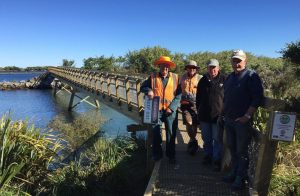
Blackball: Embracing Opportunity
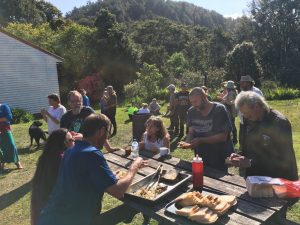
The town of Blackball is stepping up to meet the opportunities predicted to come from the new Paparoa Track and Pike29 Memorial Track between Blackball and Punakaiki. The latest addition to New Zealand’s Great Walks, this track is expected to attract 6000 people per year when it opens in 2019.
Since the announcement of the new track in 2015, the residents of Blackball – a town of 300 – have spent the last two years working with the Department of Internal Affairs (DIA) knitting together a unified outlook and building strategic relationships with national and local authorities. Determined to keep the vision and values of the local community at the heart of decisions for the town as tourism grows, Blackball has entered into a partnership for community-led development with DIA. With DIA offering five years of support, the residents plan to use this opportunity to achieve significant community-driven change in their town.
“The partnership is less about funding and more about working together as a community with common goals and aspirations” – Cynthia Robins, member of the Steering Committee
Building diverse and collaborative local leadership
A volunteer Steering Committee formed after an inspirational workshop co-hosted by Inspiring Communities and neighbourhood-building champion Jim Diers. While leaders in their own right, they will be the first to say that it is the community that leads change in Blackball. The Committee forges strategic relationships, tackles roadblocks to progress, and brings the community together when it’s time for action.
Using shared local visions to drive action and change
The residents of Blackball see their community as their greatest strength. They use town meetings, postal and online surveys, door-knocking and anonymous voting ballots placed in local businesses to ensure that every single resident of the town has an opportunity to put forward ideas and participate in decisions. At no point in the idea development or decision-making process is there a single leader or group making decisions on behalf of everyone else.
“We try very hard not to be a benign dictatorship. We open the dialogues with the right organisations and advocate for the community of Blackball to make things happen” – Cynthia Robins
Many people, groups and sectors working together
For a period of four months, the Committee met every week with representatives from DOC, DIA, Development West Coast, Grey District Council and Tai Poutini Polytech, forging strong alliances and planning a community open day. Roadblocks are a natural part of any development project and these relationships are key to gaining outcomes.
Over the last two years, the residents of Blackball have become fully engaged in being part of the change they want to see in their town.
“The community leads. The Committee is just there holding all the different strings but it is the community that pulls the reins” – Cynthia Robins
Embracing the new opportunities offered through their partnership with DIA, the town is determined to learn from the support they will receive over the next five years so that they emerge fully empowered to create the changes they want for their community.

